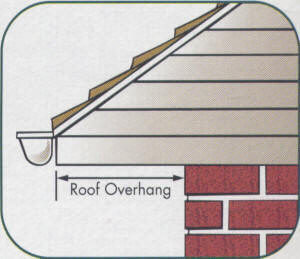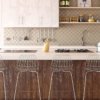
What Type Of Roofline Does My House Need?
The look of your new roof is important. But choosing a roofline for your new home combines several factors. You need to take into account the weight, materials, cost, and installation. Purpose is also relevant. Roofs not only protect you from the elements, but they can also add more space, change the lighting of your house, and can help your household reduce your energy footprint.
(One thing: When you talk to your home designer about roofs, you measure it in “squares,” rather than square feet. One square equals 100 square feet. For example, the average 2,000 square foot house would need about 15 squares of roof.)
Roof shape is tied to complexity. Simpler roof designs like a gable roof are simpler to install and therefore less expensive. If there are no breaks like vent pipes or chimneys, that’s also simpler. Roofs with several chimneys, intersecting rooflines, or skylights will be more expensive.
Types of Roofs:
The type of roof you choose depends on your chosen home design. If you’re interested in combining styles for a custom home design, you will have a little more flexibility. But it’s important to pick the correct roof for your area’s climate. After that, you can decide whether or not you’d like the roof to add more living space.
Gable roof, a.k.a. pitched or peaked roofs

These are the commonly-seen, simplest triangle shaped roofs. Most materials are compatible with this type of roof. They let precipitation roll off and leave space for attics or vaulted ceilings. However, they are vulnerable in hurricane areas, especially if there is too much overhang. These roofs will collapse if not well-supported.
Side gables are the basic pitched roofs. Two panels come together in the middle to form a triangle shape.
Crossed gables are two gable roofs sections that intersect at right angles.
Hip roof

These have slopes on four sides. They converge at the top at what is known as the ridge. They are more stable than gable roofs and are also good in areas with a lot of rain or snow. You will be able to make additions. However, they are more complicated to build because of the additional seams and come with additional installation costs.
Simple hip roofs are most common. They have triangles on two ends, and a quadrilateral on the other two sides.
Cross-hipped roofs are two simple hip roofs that come together at right angles. These would be best for homes with different wings.
Mansard Roof, a.k.a. French roof

Image courtesy of http://www.constructpi.com/pros-and-cons-mansard-roof/
These roofs have four sides that have different slopes. The very top of a mansard roof has a low pitch, while the lower slopes are very steep. These types of roofs allow you to create extra living space just under the roof, and will allow you flexibility in making additions later. However, these are not good for areas that receive snowfall, and the embellished look of most mansard roofs increases the cost. Most materials can be used, but metal is often chosen because it increases the aesthetic value.
Gambrel roof, a.k.a. barn roof

Image courtesy of http://peterballs.weebly.com/uploads/1/1/6/4/11649327/4474084_orig.jpg
These, like mansard roofs, also have two different pitches, but gambrels have only two slopes. These are often seen on barns, farm houses, and cabins. With only two roof beams, they are easier to frame out and build, and provide extra living space. However, these are less likely to stand up to heavy wind and snow, and require more maintenance.
Flat roofs

These seem to be completely flat, but they usually have a slight pitch for drainage. These provide extra space for a patio or even a penthouse room, and you can also install several solar panels. They are simple to build, but the lower pitch makes water damage a very real possibility. Maintenance is key.
There are other popular roof types, like skillion roofs, jerkinheads, bonnet roofs, and sawtooth roofs, but they are simply combinations and variations on these basic roofs.
What Material Is Best for My Roof?
Roof materials are as varied as the types of roofs. You can choose clay tiles, slate, concrete, asphalt, wood, or composite shingles. But it depends on the shape of the roof. Steeper pitches require different materials, while flat roofs can accommodate others. Also, the weight of the materials must complement the structure of your new home.
Asphalt: This is the least expensive and easiest to handle material, so it’s very common. It’s actually made out of a mix of fiberglass and asphalt. There are both single-thickness and laminated, thicker shingles. The thicker shingles have a more interesting, textured appearance, but they don’t last as long.
Wood: It’s often not allowed because of fire codes. Cedar, southern pine, and redwood are the most popular materials. They last about as long as the asphalt, but cost about twice as much.
Metal: This is a very durable surface, and more expensive. Steel, aluminum, copper-and-asphalt, and copper are most used. Metal roofs can consist of shingles or lengths of metal that are soldered together.
Tile and Cement: Spanish Mission-style houses commonly have tiled roofs. Cement can be used to the same effect. This material is very heavy, durable, and expensive.
Slate: This material is the most durable you can choose, and often it will last longer than the fasteners used to put it together. These roofs can actually last for a hundred years. It’s extremely expensive and very heavy.
Of course, a roof is not just made of shingles. Building felt or tar paper is applied to the roof before the shingles are installed. Some cedar roofs will require furring strips that allow the roof to “breathe.” Depending on your climate, you might require a snow and ice shield for extra protection.
The Details
Now that you’ve chosen the actual shape of the roof and the materials, there are still three more details to think about.
Roof overhang: This is how much the bottom of the roof extends past the wall of the house. You might know these as the eaves and rakes of the house. The main purpose of overhang is to throw water clear of the walls of your house. But they also protect your windows, siding, and doors from rain. They are helpful for shading your windows. Not every house needs the same amount of roof overhang, but many people err on making the overhang too small to be effective.

Image courtesy of https://www.heatersplus.com/images/roofca10.jpg
Gutters: This depends on what kind of climate you live in. Houses in very dry climates don’t need them. However, most houses need gutters so that the precipitation that falls is collected and directed away from the house. This plays a key role in preventing leaks and moisture damage, particularly to the foundation and walls of the house.

Ridge vents: These are a popular type of roof vent that goes well with gable roofs. These allow the roof to be ventilated, which helps your roof last much longer. In cold weather, venting prevents ice dams and takes moisture out of the attic space. In hot weather, venting drives away hot air from the roof or attic and makes your house easier to cool. You might need another kind of vent for the roof of your choice, but venting is important for all roofs.

Image courtesy of http://homes.winnipegfreepress.com/winnipeg-real-estate-articles/renovation-design/ASK-THE-INSPECTOR-Ridge-vents-may-not-add-much-benefit/id-2814
You should never think of the roof as just the thing on top of your house. If you choose your roof wisely, with proper maintenance it’ll more than likely last you a very long time. You’ll be one step closer to turning your dream home into reality.
We understand that thinking of all these factors can be confusing. Elite Design Group is here to help.





